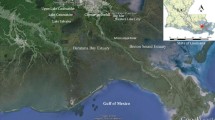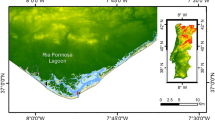Abstract
The effects of atrazine on a controlled phytoplankton community derived from a natural freshwater wetland exposed to low doses of this photosynthesis-inhibiting herbicide were examined. The community was exposed for 7 weeks to doses of 0.1, 1, and 10 μg L−1 atrazine, combined with changes in nutrient concentration, and the photosynthetic activity, biomass, and community structure were noted during the experiment. Responses of the phytoplankton community were examined in terms of photosynthetic activity, biomass, and community structure. Significant effects of atrazine on the phytoplankton assemblage, in terms of primary production and community structure, were highlighted, even at doses as low as 1 and 0.1 μg L−1, when associated with phosphorus fluctuations. The most abundant Chlorophyceae decreased in concentration with increasing atrazine dose, whereas cyanobacteria were more tolerant to atrazine, particularly with increased nutrient supply. The subinhibitory doses of atrazine used in the present study confirmed the higher sensitivity of long-term exposure of multispecies assemblages under resource competition. Our study supports the emerging hypothesis that the increasing prevalence of cyanobacterial blooms in European aquatic systems may result from a combination of unbalanced nutrient enrichment and selective pressures from multiple toxicants.





Similar content being viewed by others
References
Alekseeva T, Besse P, Binet F, Delort AM, Forano C, Josselin N, Sancelme M, Tixier CT (2006) Influence of components from soil and earthworm cast on atrazine adsorption and biodegradation. Eur J Soil Sci 57(3):295–307
Altenburger R, Walter H, Grote M (2004) What contributes to the combined effect of a complex mixture? Environ Sci Technol 38:6353–6362
Bailer AJ, Oris JT (1993) Modelling reproductive toxicity in Ceriodaphnia tests. Environ Toxicol Chem 12:787–791
Bailer AJ, Oris JT (1997) Estimating inhibition concentrations for different response scales using generalized linear models. Environ Toxicol Chem 16:1554–1559
Bérard A, Pelte T, Menthon E, Druart J-C, Bourrain X (1998) Caractérisation du phytoplancton de deux systèmes limniques vis-à-vis d’un herbicide inhibiteur de la photosynthèse. La méthode PICT (pollution induced community tolerance): application et signification. Ann Limnol 34:269–282
Bérard A, Leboulanger C, Pelte T (1999) Tolerance of Oscillatoria limnetica Lemmermann to atrazine in natural phytoplancton populations and in pure culture: influence of season and temperature. Arch Environ Contam Toxicol 37:472–479
Bérard A, Dorigo U, Mercier I, Becker-Van-Slooten K, Grandjean D, Leboulanger C (2003) Comparaison of the ecotoxicological impact of the triazines Irgarol 1051 and atrazine on microalgal cultures and natural microalgal communities in lake Geneva. Chemosphere 53:935–944
Benzécri JP (1973) L’analyse des correspondances. Dunod, Paris
Connell JH (1978) Diversity in tropical rain forests and coral reefs. Science 199:1302–1310
deNoyelles F Jr, Kettle WD, Sinn DE (1982) The response of plankton communities in experimental ponds to atrazine, the most heavily used pesticide in the United States. Ecology 63:1285–1293
DIREN Bertagne (2001) L’eau en Bretagne-Bilan 2000. Direction Régionale de l’Environnement Bretagne
Donohue I, Irvine K (2008) Quantifying variability within waters samples: the need for adequate subsampling. Water Res 42:476–482
Egorova EA, Bukhov NG (2006) Mechanisms and functions of photosystem I-related alternative electron transport pathways in chloroplasts. Russ J Plant Physiol 53:645–657
Garcia-Villada L, Rico M, Altamirano M, S!anchez-Martin L, Lopez-Rodas V, Costas E (2004) Occurrence of copper resistant mutants in the toxic cyanobacteria Microcystis aeruginosa: characterisation and future implications in the use of copper sulphate as algaecide. Water Res 38:2207–2213
Graymore M, Stagnitti F, Allinson G (2001) Impacts of atrazine in aquatic ecosystems. Environ Int 26:483–495
Gustavson K, Wangberg SA (1995) Tolerance induction and succession in microalgae communities exposed to copper and atrazine. Aquatic Toxicol 32:283–302
Hambright KD, Zohary T (2000) Phytoplankton species diversity controlled through competitive exclusion and physical disturbances. Limnol Oceanogr 45:110–122
Hayes T, Haston K, Tsui M, Hoang A, Haeffele C, Vonk A (2003) Atrazine-induced hermaphroditism at 0.1 ppb in American leopard frogs (Rana Pipiens): laboratory and field evidence. Environ Health Persp 111:568–575
Huber W (1993) Ecotoxicological relevance of atrazine in aquatic systems. Environ Toxicol Chem 12:1865–1881
IFEN (2006) Les pesticides dans les eaux—données 2003 et 2004. Dossier de l’Institut Français de l’Environnement. IFEN
Jarvie HP, Neal C, Withers PJA (2006) Sewage-effluent phosphorus: A greater risk to river eutrophication than agricultural phosphorus? Sci Total Environ 360:246–253
Klassen HE, Kadoum AM (1979) Distribution and retention of atrazine and carbofuran in farm pond ecosystems. Arch Environ Contam Toxicol 8:345–353
Koenig F (1990) Shade adaptation in cyanobacteria-Further characterization of Anacystis shade phenotype as induced by sublethal concentrations of DCMU-type inhibitors in strong light. Photosynth Res 26:29–37
Lampert W, Fleckner W, Pott E, Schober U, Störkel K-U (1989) Herbicide effects on planktonic systems of different complexity. Hydrobiologia 188–189:415–424
Leboulanger C, Rimet F, Lacotte MH, Berard A (2001) Effects of atrazine and nicosulfuron on freshwater microalgae. Environ Int 26:131–135
Lockert CK, Hoagland KD, Siegfried BD (2006) Comparative sensitivity of freshwater algae to atrazine. Bull Environ Contam Toxicol 76:73–79
Lorenzen CJ (1967) Determination of chlorophyll and phaeo-pigments: spectrophotometric equations. Limnol Oceanogr 12:343–346
Ma J, Lu N, Qin W, Xu R, Wang Y, Chen X (2006) Differential responses of eight cyanobacterial and green algal species, to carbamate insecticides. Ecotoxicol Environ Safety 63:268–274
Murphy MB, Hecker M, Coady KK, Tompsett AR, Jones PD, Du Preez LH, Everson GJ, Solomon KR, Carr JA, Smith EE, Kendall RJ, Van der Kraak G, Giesy JP (2006) Atrazine concentrations, gonadal gross morphology and histology in ranid frogs collected in Michigan agricultural areas. Aquatic Toxicol 76:230–245
Naselli-Flores L, Padisak J, Dokulil MT, Chorus I (2003) Equilibrium/steady-state concept in phytoplankton ecology. Hydrobiologia 502:395–403
Navarro E, Guasch H, Sabater S (2002) Use of microbenthic algal communities in ecotoxicological tests for the assessment of water quality: the Ter river case study. J Appl Phycol 14:41–48
Nicholls K, Dillon P (1978) An evaluation of phosphorus-chlorophyll-phytoplankton relationships of lakes. Int Rev Gesamten Hydrobiol 63:141–154
Reynolds CS, Padisak J, Sommer U (1993) Intermediate disturbance in the ecology of phytoplankton and the maintenance of species diversity: a synthesis. Hydrobiologia 249:183–188
Reynolds CS, Huszar V, Kruk C, Naselli-Flores L, Melo S (2002) Towards a functional classification of the freshwater phytoplankton. J Plank Res 24:417–428
Schwarzenbach RP, Escher BI, Fenner K, Hofstetter TB, Johnson CA, von Gunten U, Wehrli B (2006) The challenge of micropollutants in aquatic systems. Science 313:1072–1077
Seguin F, Leboulanger C, Rimet F, Druart J-C, Bérard A (2001) Effects of atrazine and nicosulfuron on phytoplankton in systems of increasing complexity. Arch Environ Contam Toxicol 40:198–208
Seguin F, Bihan FL, Leboulanger C, Berard A (2002) A risk assessment of pollution: induction of atrazine tolerance in phytoplankton communities in freshwater outdoor mesocosms, using chlorophyll fluorescence as an endpoint. Water Res 36:3227–3236
Simpson EH (1949) Measurement of diversity. Nature 163:688
Solomon KR, Baker DB, Richards RP, Dixon KR, Klaine SJ, La Point TW, Kendall RJ, Giddings JM, Giesy JP, Hall LW Jr, Williams WM (1996) Ecological risk assessment of atrazine in North American surface waters. Environ Toxicol Chem 15:31–76
Sommer U (1995) An experimental test of the intermediate disturbance hypothesis using cultures of marine phytoplankton. Limnol Oceanogr 40:1271–1277
Steemann-Nielsen E (1952) The use of radioactive carbon (14C) for measuring organic production in the sea. J Cons Int Explor Mer 18:117–140
Tang JX, Hoagland KD, Siegfried BD (1997) Differential toxicity of atrazine to selected freshwater algae. Bull Environ Contam Toxicol 59:631–637
Tang J, Hoagland KD, Siegfried BD (1998) Uptake and bioconcentration of atrazine by selected freshwater algae. Environ Toxicol Chem 17:1085–1090
Tilman D (1982) Resource competition and community structure. Princeton University Press, Princeton, NJ
World Health Organization (2000) Atrazine. In: Directives pour la qualité de l’eau de boisson, vol 2. Critères d’hygiène et documentation à l’appui. WHO, Genève, pp 654–661
Acknowledgments
This study received financial support from the CNRS through the PEVS/Tranzat program awarded to F. Binet. We are grateful to the people who helped with laboratory analyses and species determination: M. P. Briand, N. Josselin, and L. Brient, from UMR Ecobio, and S. Nogre and J. Morvan, from the Ecole Nationale Supérieure de Chimie at Rennes. We also thank M. Bormans and the two anonymous reviewers for their useful comments on the manuscript.
Author information
Authors and Affiliations
Corresponding authors
Rights and permissions
About this article
Cite this article
Pannard, A., Le Rouzic, B. & Binet, F. Response of Phytoplankton Community to Low-Dose Atrazine Exposure Combined with Phosphorus Fluctuations. Arch Environ Contam Toxicol 57, 50–59 (2009). https://doi.org/10.1007/s00244-008-9245-z
Received:
Accepted:
Published:
Issue Date:
DOI: https://doi.org/10.1007/s00244-008-9245-z




